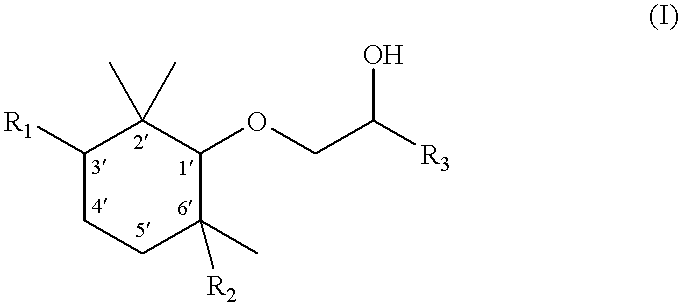Optically active, oxygenated, alicyclic compounds and their use as perfuming ingredients
a technology of alicyclic compounds and oxygenated compounds, which is applied in the field of optically active, oxygenated, alicyclic compounds, can solve the problems of difficult and costly synthesis of pure, optically active isomers, and the inability to determine a priori
- Summary
- Abstract
- Description
- Claims
- Application Information
AI Technical Summary
Problems solved by technology
Method used
Image
Examples
example 2
[0063] Stereoselective preparation of the four optically active isomers of 1-(2,2,3,6-tetramethyl-1-cyclohexyloxy)-2-pentanol
[0064] 1. (+)-(1R,3S,6S)-2,2,3,6-Tetramethylcyclohexanol
[0065] a) (1S, 2R, 5S)-2-Isopropenyl-5-methylcyclohexanol [(+)-isopulegol]
[0066] A 2 1 flask fitted with a mechanical stirrer and in an argon atmosphere was filled with 250 g of (-)-S-citronellal (enantiomeric excess >98%) (1.62 mol) and 0.8 1 of anhydrous toluene. The mixture was cooled to -5.degree. in a bath of acetone and ice while 365 g of anhydrous zinc bromide (1.63 mol) were added in 10 portions over 2.5 h. The mixture was stirred for a further 2 h at -5.degree. until conversion was complete, as indicated by GLC (gas-liquid chromatography) (Carbowax column, 15 m, 1000, 15.degree. / min. up to 2200). The reaction mixture was then filtered. The filtrate was washed with brine, then dried over sodium sulphate. Evaporation under a vacuum of 2.6.times.10 Pa produced 262 g of raw concentrate. A sample of t...
example 3
[0146] Stereoselective preparation of the mixture of (1'R,2S,3'S,6'S)-1-(2',2',3',6'-tetramethyl-1'-cyclohexyloxy)-2-pentanol and (1'S,2S,3'R,6'R)-1-(2',2',3',6'-tetramethyl-1'-cyclohexyloxy)-2-penta-nol by the Corey reduction method
[0147] 1. (+)-2,2,c-3,t-6-Tetramethyl-R-1-cyclohexanol
[0148] The reaction was carried out in a 1.5 1 double-walled Schmizo flask fitted with a mechanical stirrer, an adding funnel, a condenser and a thermometer in an argon atmosphere, in which 500 ml of toluene and 22.5 g of metallic sodium (1.0 mol) were heated to reflux for a period of 15 min. The molten two-phase toluene / metal mixture was cooled during vigorous stirring (mechanical stirring with Medimex.RTM. transmission) and the metal solidified in the form of small spheres. At 0.degree., a solution of 54 g of 2,2,3,6-tetramethyl-cyclohexanone (0.35 mol) in 150 g of isopropanol (2.5 mol) was added dropwise over a period of 3 h. The reaction mixture was stirred at 0.degree. overnight, and gas-liquid c...
example 4
[0185] Preparation of a Perfuming Composition
[0186] A perfuming composition for a fabric softener was prepared from the following ingredients:
1 Ingredients Parts by weight Benzyl acetate 10 Citronellyl acetate 30 Cinnamic alcohol 25 Fenchyl alcohol at 10%* 15 Benzoic aldehyde at 10%* 130 Lenic aldehyde C 11 at 10%* 30 Aldehyde C12 at 50%* 20 Hexylcinnamic aldehyde 405 2-Methylundecanal at 10%* 45 Ambrox .RTM. .sup.1) at 10%* 20 Methyl anthranilate 40 .gamma.-Undecalactone 35 Raspberry ketone at 1%* 80 Methyl benzoate at 10%* 45 Camphor 20 Citronellol 130 Allylphenoxyacetate 10 Cournarin 80 Alpha damascone at 1%* 40 Ethyl vanillin 45 Eugenol F 165 Galaxolide .RTM. .sup.2) 220 Hedione .RTM. .sup.3) 300 Heliotropine 30 Synth. hydroxycitronellal at 10%* 80 Iralia .RTM. .sup.4) 490 Lilial .RTM. .sup.5) 110 Linalol 20 Lyral .RTM. .sup.6) 75 Mandarin essential oil 50 Methyl eugenol at 10%* 50 Cryst. methyl naphthyl ketone 40 Crystal moss 40 Oxide of rose 20 Paracresol extra at 10%* 20 Patc...
PUM
| Property | Measurement | Unit |
|---|---|---|
| enantiomeric excess | aaaaa | aaaaa |
| volume | aaaaa | aaaaa |
| optically active | aaaaa | aaaaa |
Abstract
Description
Claims
Application Information
 Login to View More
Login to View More - R&D
- Intellectual Property
- Life Sciences
- Materials
- Tech Scout
- Unparalleled Data Quality
- Higher Quality Content
- 60% Fewer Hallucinations
Browse by: Latest US Patents, China's latest patents, Technical Efficacy Thesaurus, Application Domain, Technology Topic, Popular Technical Reports.
© 2025 PatSnap. All rights reserved.Legal|Privacy policy|Modern Slavery Act Transparency Statement|Sitemap|About US| Contact US: help@patsnap.com



